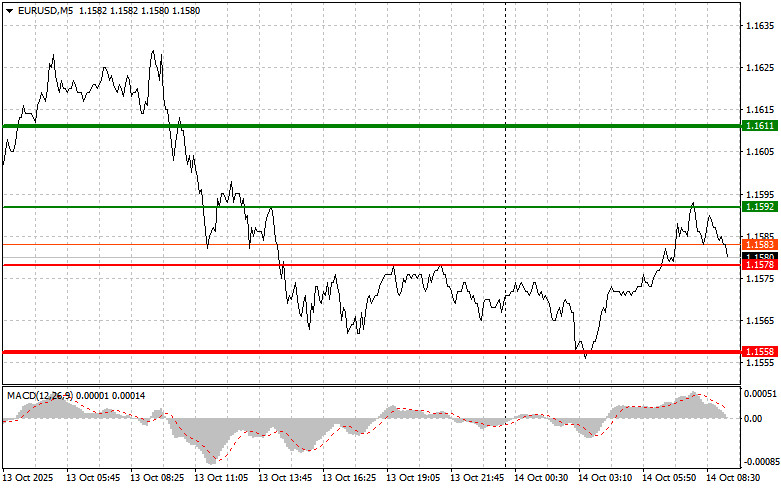The test of the 1.1584 level occurred when the MACD indicator had just begun to move down from the zero line—this served as confirmation of a proper entry point for selling the euro. As a result, the pair declined to the target level of 1.1562.
Potential trade restrictions between China and the United States continue to weigh on the global economy and risk-sensitive assets, including the euro. Investors are concerned that escalating tensions between the world's two largest economies could hinder global growth. The euro's future upward trajectory also remains at risk, as the European Central Bank might be forced to return to stimulating the Eurozone economy if the trade conflict deepens.
This morning, important economic reports are expected: the ZEW Economic Sentiment Index for the euro area and the German Consumer Price Index (CPI). These releases may temporarily influence the euro's dynamics, though their long-term effect on the currency market should not be overestimated. The ZEW index is a leading indicator of Eurozone economic health, reflecting expert and institutional investor forecasts. Values exceeding expectations may suggest optimism in the business environment and support the euro. It is important to remember that this index reflects sentiment rather than the actual state of the economy.
The German CPI is the key inflation measure for the largest economy in the euro area. Actual readings above projections could increase pressure on the ECB. On the other hand, weak CPI figures may drag the euro down due to increased expectations of interest rate cuts.
As for the intraday strategy, I will rely mainly on Scenarios 1 and 2.
Scenario 1: I plan to buy the euro today at the 1.1592 level (green line on the chart) with a target at 1.1611. At 1.1611, I will exit the market and consider selling on the rebound, expecting a pullback of 30–35 pips from the entry point. A bullish outlook on the euro is only appropriate after strong economic data. Important: Before initiating a buy, make sure that the MACD indicator is above the zero line and has just begun to rise from it.
Scenario 2: I also plan to buy the euro today if the price tests the 1.1578 level twice in a row while the MACD indicator is in oversold territory. This would limit the pair's downside potential and lead to an upward market reversal. In this case, I expect growth toward the opposite levels of 1.1592 and 1.1611.
Scenario 1: I plan to sell the euro after the price reaches 1.1578 (red line on the chart) with a target at 1.1558. I will exit the market there and consider buying on the rebound, expecting a 20–25 pip move in the opposite direction. Pressure on the pair is unlikely to return today. Important: Before initiating a sell, ensure that the MACD indicator is below the zero line and just beginning to decline from it.
Scenario 2: I also intend to sell the euro today if the price tests the 1.1592 level twice in a row while the MACD indicator is in overbought territory. This would limit the pair's upward potential and lead to a downward reversal. I would then expect a decline toward the opposite levels of 1.1578 and 1.1558.

Important. Beginner traders in the Forex market should be cautious when deciding to enter the market. Before major fundamental releases, it is best to remain out of the market to avoid sharp price swings. If trading during the news, always use stop-loss orders to minimize losses. Without proper stop-loss levels, you can quickly lose your entire deposit—especially if you don't use money management and trade with large volumes.
And remember: to trade successfully, you must follow a clear trading plan, such as the one presented above. Making spontaneous trades based on short-term price action is a losing strategy for any intraday trader.

QUICK LINKS